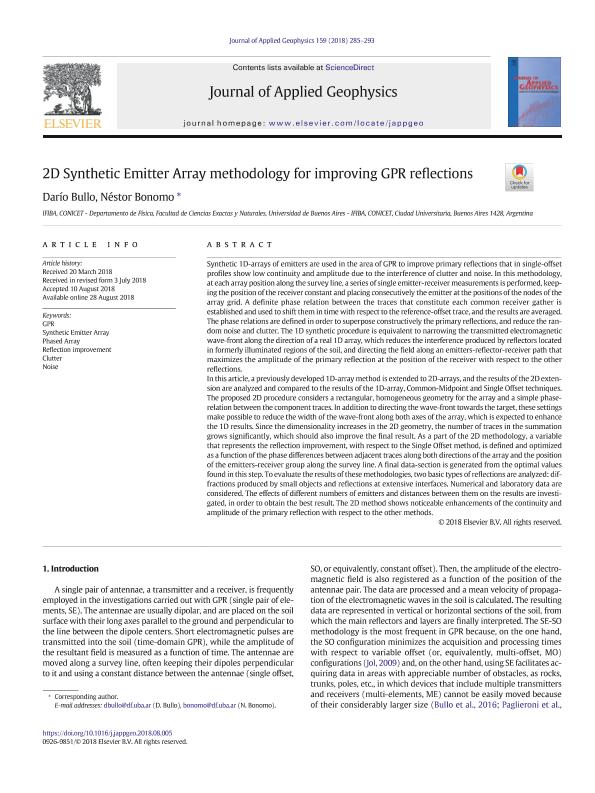Mostrar el registro sencillo del ítem
dc.contributor.author
Bullo, Darío Ezequiel

dc.contributor.author
Bonomo, Nestor Eduardo

dc.date.available
2022-12-19T14:35:00Z
dc.date.issued
2018-12
dc.identifier.citation
Bullo, Darío Ezequiel; Bonomo, Nestor Eduardo; 2D Synthetic Emitter Array methodology for improving GPR reflections; Elsevier Science; Journal Of Applied Geophysics; 159; 12-2018; 285-293
dc.identifier.issn
0926-9851
dc.identifier.uri
http://hdl.handle.net/11336/181734
dc.description.abstract
Synthetic 1D-arrays of emitters are used in the area of GPR to improve primary reflections that in single-offset profiles show low continuity and amplitude due to the interference of clutter and noise. In this methodology, at each array position along the survey line, a series of single emitter-receiver measurements is performed, keeping the position of the receiver constant and placing consecutively the emitter at the positions of the nodes of the array grid. A definite phase relation between the traces that constitute each common receiver gather is established and used to shift them in time with respect to the reference-offset trace, and the results are averaged. The phase relations are defined in order to superpose constructively the primary reflections, and reduce the random noise and clutter. The 1D synthetic procedure is equivalent to narrowing the transmitted electromagnetic wave-front along the direction of a real 1D array, which reduces the interference produced by reflectors located in formerly illuminated regions of the soil, and directing the field along an emitters-reflector-receiver path that maximizes the amplitude of the primary reflection at the position of the receiver with respect to the other reflections. In this article, a previously developed 1D-array method is extended to 2D-arrays, and the results of the 2D extension are analyzed and compared to the results of the 1D-array, Common-Midpoint and Single Offset techniques. The proposed 2D procedure considers a rectangular, homogeneous geometry for the array and a simple phase-relation between the component traces. In addition to directing the wave-front towards the target, these settings make possible to reduce the width of the wave-front along both axes of the array, which is expected to enhance the 1D results. Since the dimensionality increases in the 2D geometry, the number of traces in the summation grows significantly, which should also improve the final result. As a part of the 2D methodology, a variable that represents the reflection improvement, with respect to the Single Offset method, is defined and optimized as a function of the phase differences between adjacent traces along both directions of the array and the position of the emitters-receiver group along the survey line. A final data-section is generated from the optimal values found in this step. To evaluate the results of these methodologies, two basic types of reflections are analyzed: diffractions produced by small objects and reflections at extensive interfaces. Numerical and laboratory data are considered. The effects of different numbers of emitters and distances between them on the results are investigated, in order to obtain the best result. The 2D method shows noticeable enhancements of the continuity and amplitude of the primary reflection with respect to the other methods.
dc.format
application/pdf
dc.language.iso
eng
dc.publisher
Elsevier Science

dc.rights
info:eu-repo/semantics/openAccess
dc.rights.uri
https://creativecommons.org/licenses/by-nc-sa/2.5/ar/
dc.subject
CLUTTER
dc.subject
GPR
dc.subject
NOISE
dc.subject
PHASED ARRAY
dc.subject
REFLECTION IMPROVEMENT
dc.subject
SYNTHETIC EMITTER ARRAY
dc.subject.classification
Geoquímica y Geofísica

dc.subject.classification
Ciencias de la Tierra y relacionadas con el Medio Ambiente

dc.subject.classification
CIENCIAS NATURALES Y EXACTAS

dc.title
2D Synthetic Emitter Array methodology for improving GPR reflections
dc.type
info:eu-repo/semantics/article
dc.type
info:ar-repo/semantics/artículo
dc.type
info:eu-repo/semantics/publishedVersion
dc.date.updated
2022-07-15T14:54:32Z
dc.journal.volume
159
dc.journal.pagination
285-293
dc.journal.pais
Países Bajos

dc.journal.ciudad
Amsterdam
dc.description.fil
Fil: Bullo, Darío Ezequiel. Consejo Nacional de Investigaciones Científicas y Técnicas. Oficina de Coordinación Administrativa Ciudad Universitaria. Instituto de Física de Buenos Aires. Universidad de Buenos Aires. Facultad de Ciencias Exactas y Naturales. Instituto de Física de Buenos Aires; Argentina
dc.description.fil
Fil: Bonomo, Nestor Eduardo. Consejo Nacional de Investigaciones Científicas y Técnicas. Oficina de Coordinación Administrativa Ciudad Universitaria. Instituto de Física de Buenos Aires. Universidad de Buenos Aires. Facultad de Ciencias Exactas y Naturales. Instituto de Física de Buenos Aires; Argentina
dc.journal.title
Journal Of Applied Geophysics

dc.relation.alternativeid
info:eu-repo/semantics/altIdentifier/url/https://www.sciencedirect.com/science/article/abs/pii/S0926985118302453
dc.relation.alternativeid
info:eu-repo/semantics/altIdentifier/doi/https://doi.org/10.1016/j.jappgeo.2018.08.005
Archivos asociados
